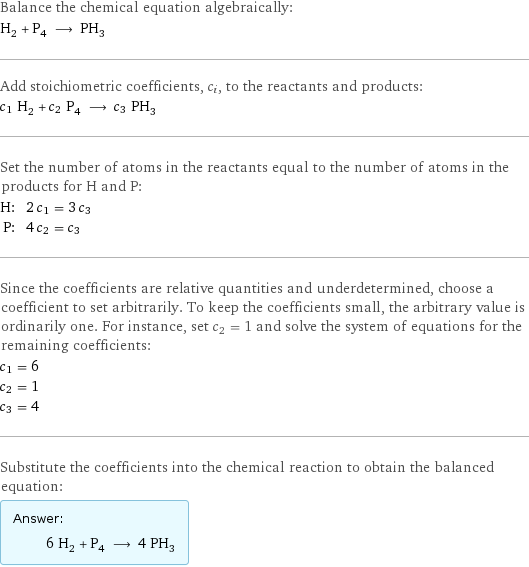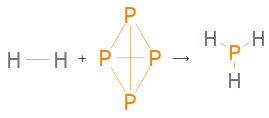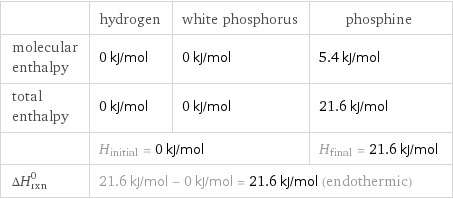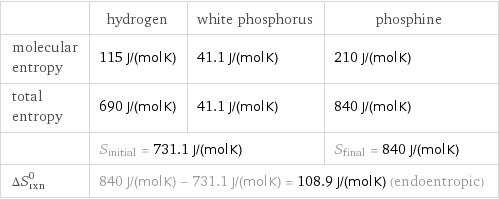Input interpretation

H_2 hydrogen + P_4 white phosphorus ⟶ PH_3 phosphine
Balanced equation

Balance the chemical equation algebraically: H_2 + P_4 ⟶ PH_3 Add stoichiometric coefficients, c_i, to the reactants and products: c_1 H_2 + c_2 P_4 ⟶ c_3 PH_3 Set the number of atoms in the reactants equal to the number of atoms in the products for H and P: H: | 2 c_1 = 3 c_3 P: | 4 c_2 = c_3 Since the coefficients are relative quantities and underdetermined, choose a coefficient to set arbitrarily. To keep the coefficients small, the arbitrary value is ordinarily one. For instance, set c_2 = 1 and solve the system of equations for the remaining coefficients: c_1 = 6 c_2 = 1 c_3 = 4 Substitute the coefficients into the chemical reaction to obtain the balanced equation: Answer: | | 6 H_2 + P_4 ⟶ 4 PH_3
Structures

+ ⟶
Names

hydrogen + white phosphorus ⟶ phosphine
Reaction thermodynamics
Enthalpy

| hydrogen | white phosphorus | phosphine molecular enthalpy | 0 kJ/mol | 0 kJ/mol | 5.4 kJ/mol total enthalpy | 0 kJ/mol | 0 kJ/mol | 21.6 kJ/mol | H_initial = 0 kJ/mol | | H_final = 21.6 kJ/mol ΔH_rxn^0 | 21.6 kJ/mol - 0 kJ/mol = 21.6 kJ/mol (endothermic) | |
Entropy

| hydrogen | white phosphorus | phosphine molecular entropy | 115 J/(mol K) | 41.1 J/(mol K) | 210 J/(mol K) total entropy | 690 J/(mol K) | 41.1 J/(mol K) | 840 J/(mol K) | S_initial = 731.1 J/(mol K) | | S_final = 840 J/(mol K) ΔS_rxn^0 | 840 J/(mol K) - 731.1 J/(mol K) = 108.9 J/(mol K) (endoentropic) | |
Equilibrium constant
![Construct the equilibrium constant, K, expression for: H_2 + P_4 ⟶ PH_3 Plan: • Balance the chemical equation. • Determine the stoichiometric numbers. • Assemble the activity expression for each chemical species. • Use the activity expressions to build the equilibrium constant expression. Write the balanced chemical equation: 6 H_2 + P_4 ⟶ 4 PH_3 Assign stoichiometric numbers, ν_i, using the stoichiometric coefficients, c_i, from the balanced chemical equation in the following manner: ν_i = -c_i for reactants and ν_i = c_i for products: chemical species | c_i | ν_i H_2 | 6 | -6 P_4 | 1 | -1 PH_3 | 4 | 4 Assemble the activity expressions accounting for the state of matter and ν_i: chemical species | c_i | ν_i | activity expression H_2 | 6 | -6 | ([H2])^(-6) P_4 | 1 | -1 | ([P4])^(-1) PH_3 | 4 | 4 | ([PH3])^4 The equilibrium constant symbol in the concentration basis is: K_c Mulitply the activity expressions to arrive at the K_c expression: Answer: | | K_c = ([H2])^(-6) ([P4])^(-1) ([PH3])^4 = ([PH3])^4/(([H2])^6 [P4])](../image_source/cbc487873e5265a54a6896b55bdcbbfa.png)
Construct the equilibrium constant, K, expression for: H_2 + P_4 ⟶ PH_3 Plan: • Balance the chemical equation. • Determine the stoichiometric numbers. • Assemble the activity expression for each chemical species. • Use the activity expressions to build the equilibrium constant expression. Write the balanced chemical equation: 6 H_2 + P_4 ⟶ 4 PH_3 Assign stoichiometric numbers, ν_i, using the stoichiometric coefficients, c_i, from the balanced chemical equation in the following manner: ν_i = -c_i for reactants and ν_i = c_i for products: chemical species | c_i | ν_i H_2 | 6 | -6 P_4 | 1 | -1 PH_3 | 4 | 4 Assemble the activity expressions accounting for the state of matter and ν_i: chemical species | c_i | ν_i | activity expression H_2 | 6 | -6 | ([H2])^(-6) P_4 | 1 | -1 | ([P4])^(-1) PH_3 | 4 | 4 | ([PH3])^4 The equilibrium constant symbol in the concentration basis is: K_c Mulitply the activity expressions to arrive at the K_c expression: Answer: | | K_c = ([H2])^(-6) ([P4])^(-1) ([PH3])^4 = ([PH3])^4/(([H2])^6 [P4])
Rate of reaction
![Construct the rate of reaction expression for: H_2 + P_4 ⟶ PH_3 Plan: • Balance the chemical equation. • Determine the stoichiometric numbers. • Assemble the rate term for each chemical species. • Write the rate of reaction expression. Write the balanced chemical equation: 6 H_2 + P_4 ⟶ 4 PH_3 Assign stoichiometric numbers, ν_i, using the stoichiometric coefficients, c_i, from the balanced chemical equation in the following manner: ν_i = -c_i for reactants and ν_i = c_i for products: chemical species | c_i | ν_i H_2 | 6 | -6 P_4 | 1 | -1 PH_3 | 4 | 4 The rate term for each chemical species, B_i, is 1/ν_i(Δ[B_i])/(Δt) where [B_i] is the amount concentration and t is time: chemical species | c_i | ν_i | rate term H_2 | 6 | -6 | -1/6 (Δ[H2])/(Δt) P_4 | 1 | -1 | -(Δ[P4])/(Δt) PH_3 | 4 | 4 | 1/4 (Δ[PH3])/(Δt) (for infinitesimal rate of change, replace Δ with d) Set the rate terms equal to each other to arrive at the rate expression: Answer: | | rate = -1/6 (Δ[H2])/(Δt) = -(Δ[P4])/(Δt) = 1/4 (Δ[PH3])/(Δt) (assuming constant volume and no accumulation of intermediates or side products)](../image_source/6165f16c75a3909bb981a675085ebd84.png)
Construct the rate of reaction expression for: H_2 + P_4 ⟶ PH_3 Plan: • Balance the chemical equation. • Determine the stoichiometric numbers. • Assemble the rate term for each chemical species. • Write the rate of reaction expression. Write the balanced chemical equation: 6 H_2 + P_4 ⟶ 4 PH_3 Assign stoichiometric numbers, ν_i, using the stoichiometric coefficients, c_i, from the balanced chemical equation in the following manner: ν_i = -c_i for reactants and ν_i = c_i for products: chemical species | c_i | ν_i H_2 | 6 | -6 P_4 | 1 | -1 PH_3 | 4 | 4 The rate term for each chemical species, B_i, is 1/ν_i(Δ[B_i])/(Δt) where [B_i] is the amount concentration and t is time: chemical species | c_i | ν_i | rate term H_2 | 6 | -6 | -1/6 (Δ[H2])/(Δt) P_4 | 1 | -1 | -(Δ[P4])/(Δt) PH_3 | 4 | 4 | 1/4 (Δ[PH3])/(Δt) (for infinitesimal rate of change, replace Δ with d) Set the rate terms equal to each other to arrive at the rate expression: Answer: | | rate = -1/6 (Δ[H2])/(Δt) = -(Δ[P4])/(Δt) = 1/4 (Δ[PH3])/(Δt) (assuming constant volume and no accumulation of intermediates or side products)
Chemical names and formulas

| hydrogen | white phosphorus | phosphine formula | H_2 | P_4 | PH_3 Hill formula | H_2 | P_4 | H_3P name | hydrogen | white phosphorus | phosphine IUPAC name | molecular hydrogen | tetraphosphorus | phosphine
Substance properties

| hydrogen | white phosphorus | phosphine molar mass | 2.016 g/mol | 123.89504799 g/mol | 33.998 g/mol phase | gas (at STP) | solid (at STP) | gas (at STP) melting point | -259.2 °C | 44.15 °C | -132.8 °C boiling point | -252.8 °C | 280.5 °C | -87.5 °C density | 8.99×10^-5 g/cm^3 (at 0 °C) | 1.823 g/cm^3 | 0.00139 g/cm^3 (at 25 °C) solubility in water | | insoluble | slightly soluble dynamic viscosity | 8.9×10^-6 Pa s (at 25 °C) | 0.00169 Pa s (at 50 °C) | 1.1×10^-5 Pa s (at 0 °C) odor | odorless | odorless |
Units
